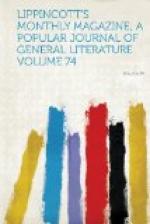In addition to this special ceremony, other Easter bounties, styled “Minor Bounty,” “Discretionary Bounty,” and the “Royal Gate Alms,” were, according to old custom, distributed at the Almonry Office on Good Friday and Saturday, while Easter Monday and Tuesday were devoted to the distribution of other supplementary relief to old and infirm people previously chosen by the clergy of the various London parishes. The recipients included over a thousand persons. Among the private local charities none is on so large a scale as the famous “Tichborne Dole.” The idea we now attach to the word dole is ludicrously inappropriate in this case, where the gift is in the proportion of one gallon of the best wheaten flour to each adult and half a gallon to each child, and where the number of the recipients is generally between five and six hundred, including the inhabitants of two parishes. This custom is seven hundred years old, and was first instituted on the Tichborne estate by Dame Mabel, the wife of Sir Roger de Tichborne, knight, in the beginning of the twelfth century. The foundress was renowned for her piety and charity, and by her own people was looked upon as a saint. The family record says that she was so charitable to the poor that, not content to exercise that virtue all her lifetime, she instituted the “dole” as a perpetual memorial of her goodness, and entailed it to her posterity. It is distributed yearly on the 25th of March. A large oil-painting, now hanging in the dining-room of Tichborne House, and representing the distribution of the “dole,” was painted in 1670, and is considered as one of the most valuable family relics. The costumes of the period are faithfully represented, most of the prominent figures are portraits, and the scene is laid within the courtyard of the old manor, with its sculptured gables and picturesque mullioned windows. The present house, roomy and comfortable as it is, is a plain, unpretending building, with no architectural features to recommend it, but the park and grounds are very beautiful, the old trees disposed in deep glades and avenues, and the situation altogether very picturesque. Since the famous trial has made everything bearing the name of Tichborne a target for curiosity, the occupants have been sadly annoyed, and access to the house was at last, in self-defence, denied to strangers who came simply as gaping sight-seers. The “dole” distribution, as we have said, takes place every year. Last spring it was attended with less show than usual, owing to the illness of the little boy who now represents the old name (the nephew of the lost Roger Tichborne), in consequence of which none of the ladies of the family were present. But despite the absence of the festal arrangements by which it is usually accompanied, the main business was the same as it has always been since Dame Mabel’s time. About nine o’clock the fine old park became thronged with men, women and children, all carrying bags and baskets in which to stow away the “bounty.”




